
PREV ARTICLE
NEXT ARTICLE
FULL ISSUE
PREV FULL ISSUE
NUMISMAGRAM MEDAL SELECTIONS: OCTOBER 2019Numismagram's Jeremy Bostwick forwarded along these interesting pieces from the October upload of new material to his website. An eclectic mix, this grouping offers, in addition to the highlights below, multiple medals from pivotal battles during the Crimean War, a couple alluring World War I issues, a few high grade 5 Kopeks of Catharine II 'the Great,' and some pleasing French agricultural plaques. Be sure to check back later this month for a selection of skulls and skeletons in medallic form just in time for Halloween! Visit numismagram.com/inventory for all of these new items. -Editor Crimean War Bronze Medal
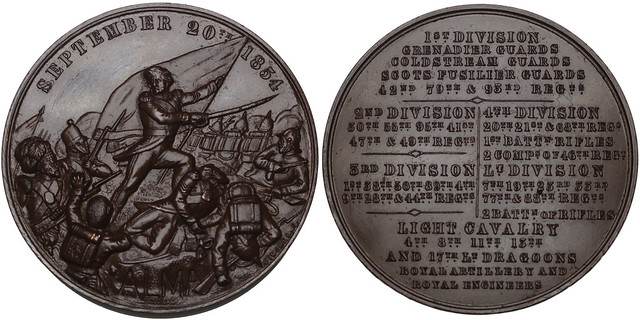 100747 | GREAT BRITAIN & RUSSIA. Crimean War bronze Medal. Issued 1854. The Battle of the Alma (41mm, 40.69 g, 12h). By Messrs Pinches. SEPTEMBER 20, 1854, troops advancing right behind standard bearer; ALMA in incuse below / Legend in 18 lines, listing the participating regiments. Edge: Plain. BHM 2539; Eimer 1490. Gem Mint State. Glossy chocolate brown surfaces, with pleasing luster. Rare in bronze. $385. Though there were many factors which led to the outbreak of the Crimean War, the main focal point involved Russia's desire for a stronger position around the Black Sea, as this water had long been important in her military strategy and might. The waning of the Ottoman Empire's power provided an opportunity to Russia around not only the Black Sea but also parts of the Balkans. Great Britain and France, neither wanting to see an expanded Russia, banded together to push back the latter. Stalled action in the southeastern Black Sea by the French and British forces caused them to turn their attention to Russia's main naval base on the Crimean peninsula at Sevastopol. This approach led to the successive battles of Alma, Balaclava, and Inkerman, the initial being an allied victory, with the latter two being more indecisive. Nevertheless, the allied presence was felt, and the assault on Sevastopol resulted in her submission, but only after nearly a year. As Russia saw more nations coming to the side of the allies, she had no choice but seek peace and an end to the war in early 1856. One of the resounding effects of their defeat was the decree that the Black Sea be neutral, preventing Russian warships from sailing there and greatly limiting her influence in this vital, warm weather weather port. Almost exactly 160 years later, Russia would again seek to stake her claim in the region, invading and annexing the peninsula away from neighboring Ukraine. This "Crimean Crisis" continues to spark debate and remains very much in dispute. Will a 21st century band of allies repulse this Russian imperialism, similar to that of Great Britain and France of the mid 1850's? Only time will tell. Heroic battle scene on the obverse, but I'm not a fan of the wordy reverse. Great history. -Editor To read the complete item description, see:
Edsel B. Ford Silver Award Medal
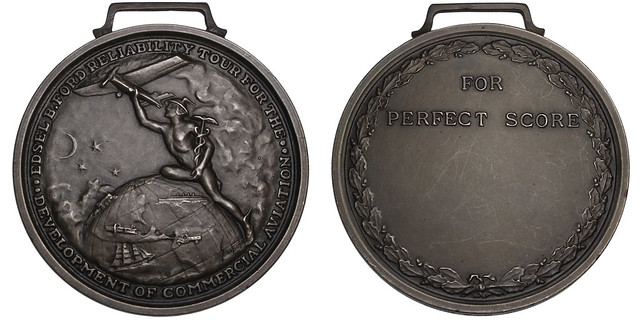 100800 | UNITED STATES. Edsel B. Ford silver Award Medal. Struck circa 1930. Issued for the "Reliability Tour for the Development of Commercial Aviation" (48mm, 60.69 g, 12h). By Gorham Manufacturing Co. • EDSEL B. FORD RELIABILITY TOUR FOR THE • / • DEVELOPMENT OF COMMERCIAL AVIATION •, Mercury flying left, holding model plane and caduceus; below in background, detailed view of the earth, focused upon North and South America, with oversized truck, train, sail boat, and steamship; crescent, stars, and clouds behind / FOR / PERFECT SCORE in two lines; field below left blank for engraving; all within wreath. Edge: GORHAM «3 hallmark» STERLING, clasp attached at top. O'Callaghan, "Ford Motor Company Tokens and Medals of Significant Interest" in TAMS XXXVI.1 (February 1996), p. 14. Choice Mint State. Immensely pleasing steel gray surfaces, with an alluring matte quality and a deeper peripheral tone. Incredibly rare and virtually never seen in the market. $765. Having been a proponent of advancing the development of commercial aviation for years, Henry Ford created the Edsel B. Ford Reliability Tour, whereby airplane manufacturers had the chance to compete in various events across the midwest in 1925. These events, beginning at the Ford Airport in Dearborn, Michigan, were held in 13 cities overall within a seven day period, and were meant to test the quality and craftsmanship of the airplanes as well as recognize the expertise of their pilots. During the tour's first year, a total of 11 of these 'perfect score' medals were awarded. The tour quickly became a popular annual affair, giving spectators the chance to see many large planes at a time when aviation was still very limited. The final year of the tour was 1932, as the depression had caused attention and funds to be diverted to more pressing economic issues. This incredibly rare and attractive medal, for pilots who achieved a "perfect score," is an unawarded type, possibly from the end of the tour when a few were left over. This cataloger could locate only three examples of this type, all from the initial year of the tour and mostly in rough shape; none of them have any market data and are privately held: Charles (Casey) Jones, Lawrence Richardson, and Glen Martin. Fascinating bit of aviation history. Great detail on the obverse - use the closeup viewer on the Numismagram site to see more. -Editor To read the complete item description, see:
Pope Julius III Bronze Medal
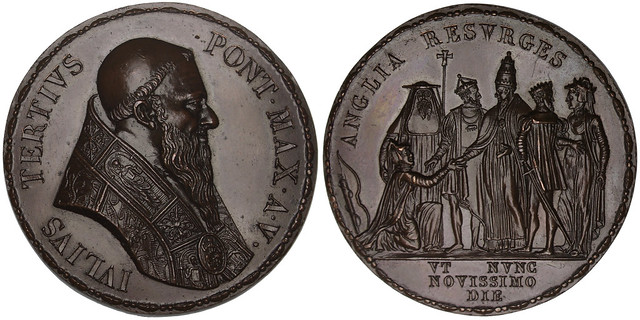 100797 | GREAT BRITAIN. England. Pope Julius III bronze Medal. Dated RY 5 (1554), though a 19th century restrike. Commemorating the brief restitution of Anglo Popery (46mm, 54.00 g, 12h). After G. Cavino. IVLIVS TERTIVS PONT MAX A V, bust right, wearing zucchetto and mantum / ANGLIA RESVRGES (England, though shall rise again...), Pope Julius standing left, raising personification of England kneeling right, casting aside bow and quiver; in background, Cardinal Reginald Pole and Holy Roman Emperor Charles V standing facing; to right, Philip and Mary standing facing one another; in three lines in exergue, VT NVNC / NOVISSIMO / DIE (...as now, at the last day). Edge: Plain. Cf. MI 70/15 (for prototype); Eimer 31c; Mazio –; cf. Lincoln 553-5 (same). Choice Mint State. Deep glossy brown surfaces with a sharp strike and intense luster. A seldom seen restrike of this rare and historically interesting type. $495. On account of Henry VIII's quarrel with Rome and Pope Clemens VII, Henry was excommunicated and thus, installed himself as the head of the newly established Anglican Church. When Mary (Henry's daughter by his first marriage to Catherine of Aragon) became queen, she wished to restore the religion of her mother and cousin, Holy Roman Emperor Charles VI (Carlos I of Spain), returning the Catholic Church to England. That very act is represented on this restrike medal, with Pope Julius III raising up the kneeling personification of England, while he is surrounded Reginald Pole (the final Catholic Archbishop of Canterbury), Charles V (Holy Roman Emperor and Mary's first cousin), Philip (Mary's husband and first cousin once removed), and Mary herself, clutching her seemingly swollen stomach in the hope of producing an heir. In the end, the pregnancy would be false and Mary would fail to have issue. Meanwhile, her reign–and the restoration of Catholicism to England–would end just a few years later in 1558 with her death at the age of 42 and the accession of her Anglican half-sister, Elizabeth I, who would return the primacy of the Church of England. So much history, just one medal. I especially like the obverse, with the Pope's intricate vestments. -Editor To read the complete item description, see:
French World War II Bronze Medal
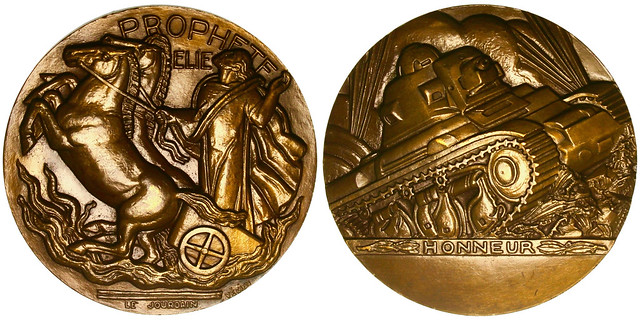 100753 | FRANCE. World War II bronze Medal. Issued circa 1940. The Prophet Elijah/Renault R35 Tank (58mm, 144.24 g, 12h). By E.-J. Vézien in Paris. PROPHETE ÉLIE, the departure of Elijah: the prophet Elijah driving biga of rearing horses, consumed by flames, left unto heaven; LE JOURDAIN in exergue / A Renault R35 tank right, with stylized explosions in background; HONNEUR below. Edge: «cornucopia» BRONZE. Choice Mint State. Pleasing yellow-brown surfaces, with exceptionally high relief. An immensely interesting Biblical/WWII hybrid type. $395. The exact meaning of these two types is not certain, though the time period during which the medal was made, along with the use of what appears to be a Renault R35 tank, would place it in the early stages of World War II–a time of great concern for Vézien's native France. The prophet Elijah was seen as a miracle worker and a harbinger of the Messiah, and so his depiction could allude to a hopeful France seeking a miracle in the wake of the Nazi onslaught. Meanwhile, the tank depicted on the reverse appears to be a Renault R35, or very similar, which would have seen use around 1940, though its slowness and inability to destroy other tanks made its effectiveness limited. In any event, a highly interesting piece of medallic art depicting a popular wartime implement. Great stylized piece. -Editor To read the complete item description, see:
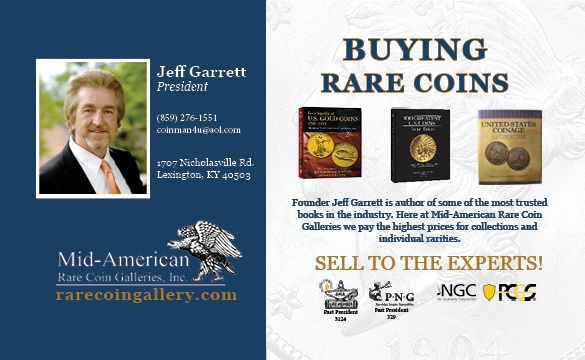 Wayne Homren, Editor The Numismatic Bibliomania Society is a non-profit organization promoting numismatic literature. See our web site at coinbooks.org. To submit items for publication in The E-Sylum, write to the Editor at this address: whomren@gmail.com To subscribe go to: https://my.binhost.com/lists/listinfo/esylum All Rights Reserved. NBS Home Page Contact the NBS webmaster 
|